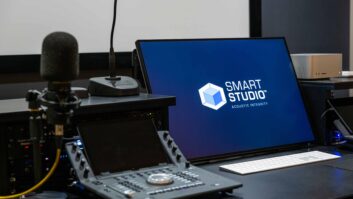
The consumer gadget market could top one trillion dollars this year with connectivity to video services driving demand. Adrian Pennington reports from last month’s CES show floor in Las Vegas.
No matter where you looked at the Consumer Electronics Show (CES) in January, everything from TVs to smartphones, cameras, Blu-ray players and consoles was being connected to the web. Within four years, predicts the Consumer Electronics Association (CEA), more than 70% of all mainstream consumer electronics (CE) products will feature online.
“The home entertainment business is suddenly really dynamic,” noted Thomas Gewecke, Warner Bros.’ digital president. “The wider adoption of Blu-ray and the influx of connected devices means digital distribution is starting to be significant.”
Bob Chapek, president of distribution for Walt Disney, added: “Virtually every living room will be directly or indirectly hooked to the TV making it a gateway to purchase content or view content you might have purchased on another networked device.”
To ram the point home Merwan Mereby, VP of corporate development at Panasonic declared that, “2011 will be the breakthrough year for connected devices” while LG Electronics’ President Wayne Park asserted: “2011 is all about smart product – smart TVs, smart mobiles and smart appliances.”
The hottest trend was the development of ‘smart TVs’ with much the same functionality as app-powered smartphones including the ability to stream video, music and photo content from ‘the clouds’ of literally hundreds of online content suppliers. DisplaySearch expects that 118m of net-enabled TVs will be sold worldwide by 2014, while iSuppli predicts an even more ambitious 148m globally for that year and Park Associates puts the 2015 figure at 185m.
After decades of defining TV as a device that is a receiver with limited broadcast content, the TV is viewed as the hub for a connected home environment encompassing smartphones, PCs and tablets or DLNA-certified appliances, joined by high-speed Wi-Fi or 4G, the new benchmark in mobile phone broadband.
Portable tablets in particular are being adopted to augment the TV experience. Sales are set to rocket to 30 million in 2011 with CE manufacturers rather than PC developers leading the charge. Sharp, Samsung, Panasonic and Sony – all with new tablets — believe that content suppliers will favour companies that sell products across the three-screen platforms of mobile, desktop and living room.
Users of Samsung’s Galaxy for example are able to remotely control and watch programming aired on Samsung TVs or Blu-ray players. Panasonic’s prototype Viera Connect tablet is designed to do something similar, while Sharp’s Galapagos uses a proprietary XDMF format that automatically adjusts digital content to the size of the screen.
John Herrington, president of Sharp North America, said the company will extend XDMF to its smartphones and connected TVs “so users can seamlessly port content from one device to another most convenient to them.”
The living room TV may remain a fixture but the type and manner in which content gets to it is evolving beyond all recognition. CE manufacturers themselves spy a slice of the action with Sony’s CEO Sir Howard Stringer stating that his company was ‘redefining TV’.
“By March more than 50 million TV screens in US homes alone will be connected to a Sony device be that PS3, Wi-Fi Blu ray player or internet TV,” he said. “That’s a significant base of connected products. But our business is no longer just about the sale of hardware. We have an equally if not more significant revenue base for content across these devices.”
It aims to pack as many entertainment options as possible into its Web-connected hardware. It has Netflix, Amazon VOD, YouTube and a library of its own shows, music and movies available for purchase or rent via its Qriocity VOD and Music Unlimited service.
Many of Panasonic’s new TVs will have Viera Connect on board, an open platform available to developers of third-party content to promote the expansion of IPTV services and applications. Samsung models will incorporate Smart Hub, a portal that unifies content search across the TV and other home networked devices, internet and VOD services.
Both Samsung and Sony struck deals with Time Warner Cable which will enable the latter’s cable subscribers to access programming direct from a Samsung or Sony connected TV without need for a set-top box. Samsung signed a similar contract with DIRECTV, and said it would add Adobe AIR 2.5 to its SmartTV and Blu-ray range for developers to more easily create, distribute and monetise applications through the Samsung Apps store.
‘TV Everywhere’
Meanwhile, IT giant Cisco unveiled an ambitious platform called Videoscape that aims to do nothing less than unify online content and digital TV with social media and communications applications. Dubbing it ‘TV Everywhere’ Cisco chairman John Chambers observed that an increasing dialogue between devices is likely to become the norm, with data stored and shared in the cloud.
Seizing on this momentum, the Digital Entertainment Content Ecosystem (DECE), a consortia backed by most major US studios and CE vendors as well as BSkyB, BT and LoveFilm in the UK, announced plans to roll out digital distribution technology UltraViolet in the US and then to the UK by the end of 2011.
The technology is designed to make approved film and TV content playable on certified devices, and is touted as a digital replacement for the ubiquitous DVD. Consumers could acquire lifetime rights to movies and shows and wouldn’t have to fear losing or breaking movies because all the material would live in the cloud and be accessible via web-connected TVs, handhelds, computers, and set-top boxes.
DECE has not however convinced Walt Disney and Apple to join them, while consumers could baulk at having to lock their content into a digital rights management system.
The demand for connectivity is credited with helping the global market for CE products to hit an all time high with revenues topping $873 billion in 2010. Growth is predicted to top one trillion dollars by the end of 2011.
3DTV
Internet-fed TV is likely to leapfrog ahead of 3DTV sales this year. “Whereas in 2010 3DTV’s were featured with internet as an add-on, in 2011 the roles are reversed and internet connectivity is the key functionality with 3D as an add-on,” noted Shawn Dubravac, the CEA’S chief economist and director of research.
One rationale for this is the amount of available programming. Connected TV content ranges from established video sources such as YouTube and the online offerings of TV networks to new creative video apps. This web content glut contrasts vividly to the relatively small library of 3D shows.
One means to plug the gap is realtime 2D-to-3D conversion which is now built-in as standard into an increasing number of 3DTVs and Blu-ray players. With a flick of the remote, consumers can turn any programme into pseudo-stereo vision.
Sony’s algorithm reads each frame and sends, for example, faster-moving objects, background objects and objects at the sides of the frame to the back of the picture. This functionality is clearly inferior to native 3D productions, can’t be recorded, and has its opponents.
“As a movie studio we made it very clear to the CE companies that we don’t support conversion at all,” declared Fox Home Entertainment President Mike Dunn. “Any time you touch it without the filmmaker, it is off limits. It distorts what everyone is trying to do. We don’t even want a football game converted like that.”
The second year of the 3DTV era saw multiple manufacturers begin to introduce additional technology options to get around some of the issues of cost, comfort and style associated with 3D active-shutter glasses. New lines from LG, Toshiba and Vizio used passive polarised glasses costing as little as $20.
There was also a proliferation of glasses-free displays using lenticular coatings to displace light on both large screens and smartphones, laptops and tablets. Most were not commercially available since, by the manufacturer’s own admission, the effect is generally only viewable from a central sweet-spot a few feet away. With individual, fixed viewpoints, mobile autostereoscopic screens are likely to take off first, perhaps fed with 3D content from the growing number of online streaming sites like 3DeeCentral, which launched featuring shortform 3D content from 30 providers.
Toshiba and LG were hedging their bets by showing passive and active glass technology as well as autosteroscopic screens. Sony revealed prototypes of a 24.5-inch OLED glasses-free screen in 1920×1080 resolution plus 46- and 56-inch 4k x 2k autostereo LCDs.
“The glasses-free area is one we are very interested in, but it’s too early to launch now since the technology has not evolved enough to bring to it to market at a reasonable price,” said Tim Page, senior manager, technology marketing, Europe. “It’s just to show we are working on the technology, that it can be done.”
Sony, Panasonic and JVC debuted 3D consumer camcorders, with Sony’s $1500 Handycam HDR-TD10 offering Full HD 3D, a 10x optical zoom and viewing on a 3.5-inch LCD autostereo screen. It uses sequential framing with left eye and right eye encoded separately 200 times a second so that Sony can claim full 1920×1080 resolution for each eye.
Could it be used for professional production? Certainly says Page. “We are seeing DSLRs being used to shoot professional features and there’s no reason why technologies such as this could not be adopted by filmmakers perhaps for run and gun shoots.”
The most eyecatching innovation was a demonstration by telco Verizon of full 1080p HD 3D video streaming in contrast to the ‘frame compatible’ 3D currently available from payTV providers. Signals were sent as IP unicast video streams over Verizon’s fibre-optic FiOS network to a Panasonic Blu-ray Disc 3D player, at 18Mbps in MPEG4, double the bit rate currently used to broadcast HD.
“Blu-ray players are about the only devices currently capable of decoding the information,” said Jimmy Ho, a member of Verizon’s technical team.







